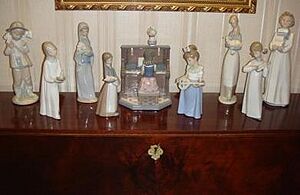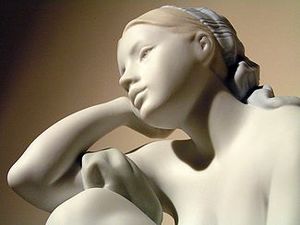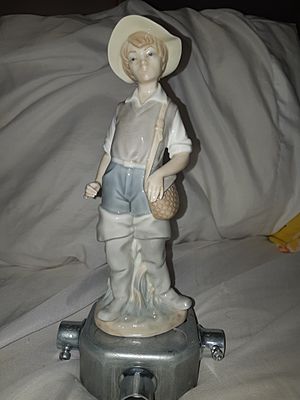Lladró facts for kids
 |
|
| S.A. (corporation) | |
| Founded | 1953 |
| Headquarters |
Tavernes Blanques
,
|
| Products | Porcelain art and figurines |
Lladró (pronounced yah-DRO) is a famous Spanish company that makes beautiful art out of porcelain. Based in a town called Tavernes Blanques in Valencia, Spain, they are known worldwide for their detailed sculptures, home decorations, and lighting.
Contents
The Story of Lladró
The company began in 1953 with three brothers: Juán, José, and Vicente Lladró. They started in a small workshop in their home village of Almàssera, making things like vases and jugs. But in 1956, they began creating the porcelain sculptures that would make them famous.
People loved their art so much that their small workshop had to get bigger and bigger. In 1958, they moved to the nearby town of Tavernes Blanques, where the company is still located today.
Growing the Dream
The brothers wanted to share their skills with others. In 1962, they opened a school at their workshop to teach people how to create porcelain art.
By 1969, their business had grown into a huge complex called the "City of Porcelain." It took two years to build and became the center for creating all Lladró art. At its peak, over 2,000 people worked there.
New Ideas and Global Reach
Over the years, Lladró continued to grow and try new things:
- 1970: The company started using earthenware, a type of clay with earthy colors, for sculptures with natural themes.
- 1973: Lladró partnered with an American company, Weil Ceramics & Glass, to sell its art in North America.
- 1974: They created a special blue logo to put on the bottom of each sculpture. This mark proved that it was a real Lladró piece.
- 1984: The next generation of the family, the children of the founding brothers, joined the company after years of training.
- 1986: Lladró teamed up with the Mitsui Group to start a new branch in Tokyo, Japan.
- 1988: The company opened its own museum and gallery in New York City.
A Club for Fans
In 1985, Lladró started the Collectors’ Society for people who loved and collected their figurines. The very first sculpture made only for members, called "Little Pals," is now very rare and valuable.
This club changed names over the years, becoming Lladró Privilege in 2001 and Lladró Gold in 2011.
Lladró Today
In recent years, Lladró has expanded beyond just figurines. In 2013, they began making fancy lights, like chandeliers and lamps. In 2016, a company called PHI Industrial Acquisitions bought a large part of the Lladró group, helping it continue to create art for the world.
How Lladró Art is Made
The exact recipe for Lladró's porcelain is a secret! The company guards it very carefully. However, we know that the figurines are made from a special, strong type of porcelain called hard-paste porcelain.
The creation process is very detailed. Artists first design and sculpt a model out of clay. Then, molds are made from this original sculpture. Liquid porcelain is poured into the molds to create the different parts of the figurine. These pieces are then carefully joined together by hand, painted with special colors, and fired in a hot kiln. This process turns the soft porcelain into a hard, beautiful work of art.
Naming the Figurines
Lladró gives each sculpture a name in Spanish, its original language. However, they also give it a different name in English.
Interestingly, the English name is often not a direct translation. Instead, the company chooses a new name that they think will appeal to English-speaking customers. Sometimes, a figurine's name might even change over the years, which can be a bit confusing!
See also
 In Spanish: Lladró para niños
In Spanish: Lladró para niños
- Porcelain manufacturing companies in Europe




